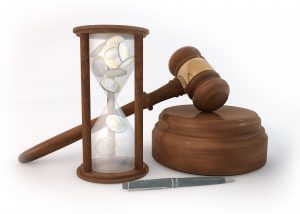To paraphrase Yogi Berra, your lawsuit ain’t over till it’s over.
In a product liability case, most lawsuits end in a settlement. The plaintiff and the defendants work the case for a period of time, and eventually they sit down and hammer out a resolution to end the case. However, some product liability cases make it all the way to trial. I have written about jury verdicts in medical device and drug cases often on this site. Recently, for example, a young boy and his family won a whopping $70,000,000.00 verdict against Johnson & Johnson based on the boy’s disfigurement caused by the drug Risperdal. In that case, as in so many others, you may think that after years of litigation and after winning a complex jury trial that the plaintiff can finally leave the court system behind and get on with his life. But the case, sadly, may just be getting started. When medical device manufacturers and drug makers lose a big case with a large money award, expect them to throw the kitchen sink at you after the jury reaches its verdict. Let’s look a few things a defense team could do if it loses a big product liability case.
Post-Trial Motions
The first thing defendants will do if they lose a trial is to file every possible post-trial motion.
- Judgment Notwithstanding the Verdict (JNOV)
This is a motion directed to the judge which asks for judgment in defendants’ favor despite the fact that the jury found in favor of the plaintiff. The argument basically goes like this: Never mind what the jury concluded. The defendants are entitled to judgment in their favor based on the applicable law. This motion first arises at the end of the plaintiff’s evidence, when the defendants ask for a judgment as a matter of law. The defendants argue, “see judge, you’ve heard all their best evidence, and given that evidence, and without putting on any defense evidence, we deserve to win this case.” If the judge denies the JMOL, defendants then put on their case. Once that is done, the jury decides who wins. If defendants lose the jury decision they can “renew” their motion for judgment as a matter of law after the verdict, which is the JNOV. Essentially, the judge at that point is not asked to tamper with the jury’s verdict, but rather to reconsider his previous decision on the original motion for judgment as a matter of law.
- Motion for New Trial
Defendants may also seek a new trial. They will argue that there were legal defects in the original trial which unfairly, even unlawfully, prejudiced the defendants and rendered the original trial void. In a recent artificial hip case in Georgia, defendants filed a motion for a new trial based on post-trial arguments that the jury verdict was inconsistent with law and flawed based on juror confusion or bias. The judge rejected that motion, but severely reduced the overall award based on a different motion, which I write about below.
- Motion to Strike Jury Awards
Motions to strike awards are pretty straightforward. The arguments go something like this: “Judge, please strike the punitive damages award because of [blank].” The “blank” could be many things: a state statute which puts a cap on punitive damages awards, or simply that the punitive damages award is unreasonably large. Unfortunately for the plaintiff, this latter reasoning prevailed in a recent Wright Conserve artificial hip case, In Re: Wright Medical Technology Inc. Conserve Hip Implant Products Liability Litigation (MDL No. 2329); Christiansen, No. 13-00297 (N.D. Ga.). In that case, the federal judge held that the evidence supported a finding that Wright Medical engaged in reprehensible conduct, which thus supported an award of punitive damages. However, he then somehow concluded that the reprehensible conduct was nevertheless well-meaning, and then randomly reduced the punitive damages award from $10,000,000.00 to $1,100,000.00, a figure he claimed was “’reasonable and proportionate to the amount of harm to the plaintiff and to the general damages recovered.’”
I still shake my head over this decision. It was a crippling blow to the plaintiff, stripping her of $8,900,000.00. Beware of post-trial motions to strike awards.
Appeals
This article focuses on actions the defendants will likely take if they lose a product liability case, but of course any losing party can utilize post-trial motions or appeals. For consistency I will stick with the fact pattern that the defendants have lost the product liability case.
If the post-trial motions are not successful, the defendants can appeal to the next highest appellate court. If the product liability trial was held in a state court, the losing party can appeal to that state’s court of appeals or to the state supreme court (whichever court is in position to review the case next). If the case was tried in federal district court, the defendants will appeal to the appropriate circuit court. There are thirteen circuit courts of appeal in the federal court system.
Regardless of whether the product liability case was tried in state or federal court, the defendants will bring similar appellate arguments and issues to the reviewing appellate court. Defendants will likely argue that the judge made a fatal error in permitting certain evidence, that other evidence unfairly prejudiced the defendants in the eyes of the jury, that the jury instructions were wrong, that the plaintiff did not prove actual or punitive damages, on and on and on.
If the defendants lose their appeal at the circuit court or at the highest state appellate court, the defendants have the right to ask for review by the United States Supreme Court. This will be a discretionary decision by the U.S. Supreme Court, and in most cases will be denied. The Supreme Court hears about eighty (80 ) cases per year, despite several thousand requests for cases to be heard. Unless the defendants can show some problematic issue of law that affects most of the states, or some overarching constitutional concern, the U.S. Supreme Court will not agree to hear the case. If that happens (or if the Supreme Court somehow chooses to hear the case and renders an opinion) the case is finally over. There is simply no where else to go.
But that can take years. At any time during that maddening drawn out appellate journey, the sides can come together and settle the case. It is as simple as this really:
Defendants: “You just won a $1,500,000.00 jury verdict against us. We plan to appeal. But if you will take $850,000.00, we will pay that and forfeit our right to appeal.”
Plaintiff: “Will you pay $1,200,000.00 instead?”
Defendants: “OK.” Case closed. (OK, it’s never that simple. But you get the idea.)
The post-trial life of a lawsuit can feel endless. It can easily take several years to work its way through all possible appellate courts. Settlements often result during this period. But if your case yields a big number at trial, expect to face post-trial motions and one or more appeals. After all, medical device and drug companies have plenty of money to pay good appellate lawyers.
 North Carolina Product Liability Lawyer Blog
North Carolina Product Liability Lawyer Blog



